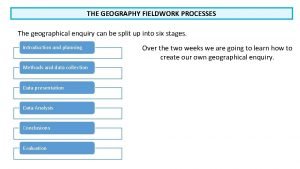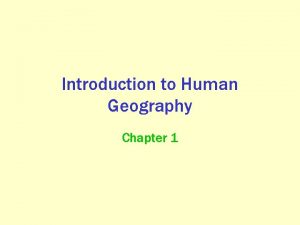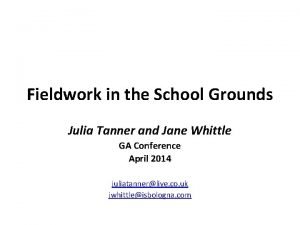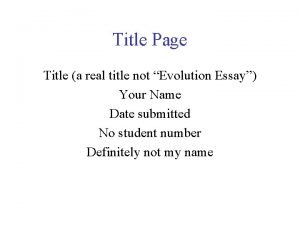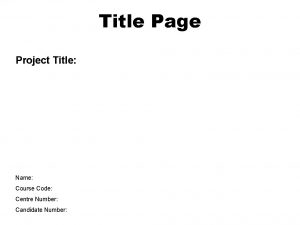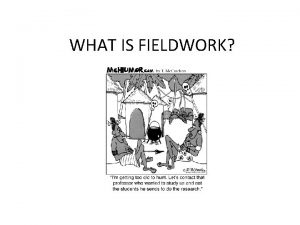GCSE GEOGRAPHY Physical Fieldwork page 1 FIELDWORK Title









- Slides: 9

GCSE GEOGRAPHY - Physical Fieldwork page 1. FIELDWORK Title. An investigation of changes in the river channel as you move downstream Hypothesis: 'There are no changes in the river channel as you move downstream’ Key questions 1 How does the channel cross section change downstream? 2. How does the velocity change downstream? 3. How does the load of the river change downstream? 4. How have people influenced the river channel? What concept(s) does this investigation link to? Channel depth, Channel width, Cross sectional area, Velocity, Discharge, Channel load. Human management. What makes this a suitable location to conduct this investigation? Toilet and cafe facilities; -Easily accessible by bus; -Large amounts of us could work on the river ; RISKS: Describe the risks you experienced on your fieldwork trip and how these could be reduced Drowning Walking alongside fast-flowing streams , so keeping to paths. In exceptional weather conditions normally dry rivers may become dangerous because of flash floods. Understand weather forecast. Ankle Injuries etc Sturdy footwear is needed for walking on uneven ground A risk of falling on algal-covered rocks. This is very common on rocks and ledges at low tide or working in river locations. Select routes carefully, step between rocks or step carefully onto horizontal surfaces. Students should wear safety helmets Data Collection Method 2: River Depth Type of data – qualitative/ quantitative Sampling Method: Stratified Sample Size: Description of method: Justification: To measure the river depth, we used a metre Depth is a simple variable which generally increases ruler. We measured the depth in cm at regular intervals from the left bank to the bank on the other side of the channel. downstream as more water is added from tributaries. It reflects the current weather conditions and also can alter if there is management by people. Strengths: Weaknesses: Collected thoroughly and accurately which meant that my results were reliable; it supported other members of your group; It was meaningful and helped me describe and analyse the data. You can draw a cross section to show the channel shape changes downstream Data Collection Method 3: Velocity Sampling Method: Stratified Sample Size: 3 at each location Description of method: We Measured out 10 metres downstream and Justification: Velocity is a measure of how fast the water moves Strengths: Objective: It is up to date (current) and we knew how the data has been collected ; Weaknesses: The use of a flow meter the accuracy would have been better • Because you are selecting the systematic technique, there is some bias (subjectivity). You decide how often to take a sample. This was one moment in time it would not reflect seasonal variations. We only measured across the centre of the river. This does not reflect variations at the sides of the river channel or within the river. then placed the float in the water at the upstream end and started timing when we let go of the float. When the float reached the end of the measured stretch we stopped timing. We repeated this three times and calculated a mean time. Data Collection Method 1: River Channel Width Type of data – qualitative / quantitative Sampling Method: Stratified Sample Size: 1 at each site Description of method: Using a tape measure, hold one end on the Justification: Width is a simple variable and generally Strengths: Objective; • It is up to date (current) and we Weaknesses: left bank and the other on the right bank, record the width in cm. Then repeat for the actual width of the river. Ensure the tape is not twisted pull the tape measure across the river and measure to the point where the water meets the bank directly opposite. . knew how the data has been collected ; increases downstream as more water is added from tributaries. The data may not be accurate if the tape was not taut. It was not measured to the point directly opposite. We did not measured across the surface of the water. Only one location in this section of the river, average not obtained. The accessibility of the site affected the sampling size. The Sampling method was not systematic as the sites were not at equal intervals downstream – so the results will show bias in site selection so may not best illustrate any changes downstream. This was one moment in time it would not reflect seasonal variations. over a specified distance (speed = distance/time) and generally increases with increasing distance downstream, as more water is added to rivers via tributary rivers. Reduced friction increases the velocity. Hence rivers flow progressively faster on their journey downstream. Steeper gradients can increase velocity. Velocity is highly influenced by channel shape or form. Wider shallow channels have larger wetted perimeters (so more friction) and hence flow slower than narrower deeper channels. People can modify channel shape and hence influence velocity.

Data Collection Method 4: River Load Type of data – qualitative / quantitative Sampling Method: Stratified and random Sample Size: 10 Description of method: To measure the load size, you need to collect 10 rocks/pebbles from the river bed, and measure the width and length of the bedload. A Roughness index was used to measure the shape of an each rock. Justification: LOAD - Stone size decreases downstream and the stones get rounder and smoother as rivers erode the rocks and transport them downstream. The processes of river erosion operate here. Strengths: This was quantitative and objective. The measurements were easy to do and the visual chart aided the roughness index. There was an element of randomness when selecting the sample. The sample size enabled an average score to be identified. Weaknesses: Some of the load have been moved to the location by tourists paddling in the stream. Some pupils deliberately picked up a sample of a particular size and shape. There was not a large enough gap between the sites for there to be significant changes downstream. Data Collection Method 5. Field notes and observations – Qualitative. Sampling Method: Stratified Sample Size: Description of method: At each site make notes to describe the characteristics. Include ideas on natural features such as , vegetation, gradients, landforms, rock type. Include ideas on human activity. Focus on any evidence of management in the river channel and why it is in place. Strengths: It will also help us to remember the details at each site and support our understanding of the changes in the river channel as you move downstream. Easy to do if you listen and contribute to discussion. Justification: This will help to assess how important natural processes in the river channel are compared to human influences. Page 2 Data Collection Method 6: Field sketch and annotated photographs Type of data – qualitative Sampling Method: Stratified Sample Size: Description of method: Justification: Identify the landscape that needs to This will help to assess how important be sketched. natural processes in the river channel 2. Write a title that will help to locate are compared to human influences. It the sketch, eg 'Site One'. will enable you to see how people have 3. Draw an outline of the main changed the ability of the river to features of the landscape with a erode, transport and deposit. The pencil, eg hills and valleys or buildings reasons for these strategies and how and roads. they relate to flooding and recreation in 4. Add detail to the sketch to record the valley. more information, eg river features, such as meanders, river cliffs and rapids. 5. Annotate or label the field sketch to give more information about the landscape and conditions, eg what was the weather like? Strengths: Weaknesses: It will help to visually record details Not being able to sketch effectively or about width, depth, load and velocity taking pictures of features which are and how these may vary and not really helpful to the key questions. influence river channel characteristics. Secondary data collection. The use of Digimaps to understand the physical relief of the area before we visited and to choose our sites for investigation. Weaknesses: Note taking needs to be detailed to be meaningful back in the classroom. If the weather is bad it can be wasted time. Data from the environment agency to establish river flows over the last 12 months for comparison with our own data. This would identify changes in discharge over the year, the risk of flooding and how effective human processes had been in reducing the flood risk.

DATA PRESENTATION METHODS Page 3 Method 1: River channel width and velocity Scatter graphs were drawn to show changes in width with distance downstream and changes in velocity with distance downstream. Strengths: Weaknesses • Quick to construct • Sample size to small to give a true • Show visually how width and distribution of points velocity change with distance • Sometimes correlation can be too downstream so two variables are weak to see significance. being compared. • Line of best fit can be • Shows trends and anomalies misinterpreted if not added • A visual line of best fit is easy to statistically. construct. What other method could be used to present your data? Justify your choice. A bar chart will show the changes from one site to another in a visual way. Easier to describe change in width or velocity at specific sites. DATA PRESENTATION METHODS Method 2 : Depth and cross section of the river channel A cross sectional graph was drawn to show the changes in the depth of the river at equal interval a cross the river channel. The river was shaded in blue and the section was annotated to describe features like pools and shallows in the river. Strengths: • Very bold and clear • Links width to depth readings • Clearly shows trends and anomalies where the channel is deeper/shallower/empty • Width changes are easy to see. • Cross sections can show a view of a segment of the river so comparisons are easy to make Weaknesses: • Difficult to construct • Exaggeration of the depth by using the wrong scale • Sometimes the edge of the river channel was difficult to plot. • The sides of the bankfull channel should have been added more accurately. What other methods could you have used to present your data? Justify your choice. A scatter graph or bar charts to show relationship between width and average depth readings. Easier to construct, would show if river becomes deeper as it gets wider. DATA PRESENTATION METHODS Method 3: Dispersion graphs to show changes in the length and width of the load for the sample of 10 stones Strengths: Weaknesses: • Easy to construct • Anomalies or unusual readings can • Give you a visual display of how the skew the results. lengths and widths are spread out. • Difficult to make visual comparisons if • Allows statistical interpretation – over crowded around one value. median, mode, range and Upper and • Difficult to calculate Median if there Lower quartiles. are several values in the middle. • Terminology difficult to understand What other method could be used to present your data? Justify your choice. Located bar charts on a base map to show average lengths, widths and shape at each of the 6/7 sites. This would show visually how the size and shape of the load changes on the ground from site 6(upper site ) to site 1 which is down stream(A spatial representation) DATA PRESENTATION METHODS Method 4 Annotated photographs At each site the observations and notes that were recorded in the field were added to photographs to show the characteristics of each site. Notes were also added to show people had modified the river channel and how it would impact on the physical(natural) processes and why these changes to the river channel had been made. Strengths: Weaknesses: Provides a visual interpretation of the The photographs did not always record landscape and a reminder. the most helpful evidence. This enables the natural characteristics Difficulty in interpreting the real life and the human influences to be seen. processes operating in the channel This helps to interpret physical and through lack of experience. human processes and their impacts. What other methods could you have used to present your data? Justify your choice. An annotated base map to show the location of human influences and management would give you a better overview of the river and the overall links between the management strategies. A field sketch constructed on the field would hold a stronger lasting impression.

Page 4 Summary of results – 11 A 1 Site 6 Channel cross section Width(cm) 300 120 Channel cross section Mean depth(cm) 4. 54 3. 78 Cross sectional area (square metres) 1, 134 545 Velocity m/sec 0. 31 m/sec 0. 08 Discharge(cubic metres per 351 second) 43. 6 Load length(cm) 5. 4 9 Load Width(cm) 3. 6 6. 4 Load shape Sub - rounded Sub - angular

Results For each of your methods/ data presentation techniques Describe the patterns and trends shown. Try to gives reasons for them. Page 5 Description of results and patterns shown Explanation for the results Method 1 River channel Width From site 6 which is upstream to site 1 which is downstream the river channel width increased. It more than doubled from 300 cm to 120 cm. There were increasingly large parts of the channel that were not occupied by the river itself, Bankfull levels were not reached at most of the sites we visited. Overall the increase in the width of the channel reflects greater levels of erosion occuring lower downstream. This means that the power to erode has increased with increasing discharge (from approx 45 cubic metres per second to 350 cubic metres per second) The discharge has increased because more water has entered the main river channel from the joining of upstream tributaries like Motts Road and New pool Hollow. More water has also entered from other parts of the catchment area as the drainage basin has collected rainfall and it has become surface run off and throughflow moving into the river channel. The erosion has changed from vertical erosion at site 6 to lateral erosion(sideways). This erodes the channel sides outwards as there is less energy lost by friction on a smaller bedload. Method 2 River Channel Depth From site 6 to site 1 the river channel depth has increased on average from 3. 78 cm to 4. 54 cm. This increase is less then expected. However This is reinforced by looking at the cross sections and the deepest pool in site 1 was 9 cm and the deepest pool in site 1 was 20 cm. Method 3 River channel Velocity The velocity of the river (speed of flow) has increased downstream. It is 3 x Faster at site 1 then site 6. 0. 3 m/sec compared to 0. 08 m/ sec. The increase in depth reflects the increase in the ability of the river channel to erode it’s bed by hydraulic action and abrasion. This increase in erosion reflects the greater discharge levels at site 1 compared to site 6. A product of more water entering this section of the channel from tributaries and a larger catchment area. Also there is less friction in site 1 due to a smaller bed load which increases the erosive capacity. The shape of the channel influences the velocity of the river. In the upper course, where the channel is narrow and uneven due to the presence of large boulders, there is a large surface area. This means there is more energy lost through friction in the upper sites. Friction results in energy loss and, consequently the velocity of the river is slowed. At site 6. As channels become larger and smoother, downstream, there is less friction to reduce velocity. So at site 1 the velocity is faster.

Page 6 Method 4 Measurements of the bedload The bedload showed a decrease in size downstream from site 6 to site 1. The long axis(length) decreased form 9 cmto 5. 4 cm on average, the short axis(width)almost halved in size form 6. 4 cm to 3. 6 cm on average. The shape of the load was sub angular mainly at site 6 whilst it was mainly sub-rounded at site 1. The change in the size and shape of the load is mainly a product of erosional processes. The energy of the river to erode by abrasion increases downstream So the sandpaper effect of the river will scrape the load along the bed and banks to reduce it’s size and make it less angular. Attrition will help with this process too, attrition will cause the pebbles and stones to crash into each other and chip bits off, reducing the length and width, whilst also smoothing it down to become more sub-rounded in shape. Results - The influence of human processes on the river channel • • • There is a lot of evidence that human processes have interacted with the physical processes taking place in the river channel. The river is heavily managed at several sites. The river is mainly managed to prevent flooding at key locations in the valley. This will impact on the discharge of water through the river channel and therefore impact upon the processes of erosion, transport and deposition. This will therefore effect river channel width , depth, velocity and load size. There was evidence of river channel management at site 7(below the reservoir) on New Pool Hollow, at site 6 (upstream above confluence of Lightspout Hollow and Motts Road and at site 2 next to the houses, café and toilets. At site 7 the river channel was quite narrow and velocity of flow was very slow. This reflected the position of the upstream reservoir. Which had reduced the discharge of water into the river channel thus making it less effective at eroding and widening and deepening it’s channel by hydraulic action and abrasion. There was also a mini dam below the site, water ponded up behind it, as the flow was controlled through a ‘V’ shaped notch over which the river flowed very slowly. The position of this management strategy was to reduce the flow into the confluence below New Pool Hollow, thus protecting the buildings and landuse further down the stream. At site 6 the channel was nearer to the source. It was the narrowest and 2 nd slowest velocity. This site was also heavily managed. The river channel sides were reinforced with limestone blocks, this was to stop the river channel eroding the surrounding landscape and protected the narrow footpath on either side of this section. To prevent flooding at the downstream confluence with Motts Road a mini dam had been constructed above it. This caused the water to pond up behind it. Thus storing the water and reducing the volume and rate at which the flow approached the confluence. At site 2 there is evidence that the river has been channelised. That is; straightened, deepened and the river banks have been reinforced. In times of heavy precipitation, and rapid surface runoff the deepened channel will have a bigger capacity to carry more water through this section. The smoother channel will reduce friction and allow the water to flow through more quickly reducing the risk of flooding by the buildings. Overall there has been a lot of human impact on physical processes within the river channel, a product of small scale management strategies throughout the river valley and it’s channel.

Page 7 Site 6 Site 2 Site 7 Site 6

1. How does the channel cross section change downstream? The channel cross section gets larger from site 6 to site 1, it nearly doubles in size from about 500 square metres to over 1000 square metres. This is because there is more water entering the main channel from tributaries and the catchment area at site 1. Therefore there is more energy to erode laterally and widen the channel. Whereas at site 6 most energy is lost through vertical erosion so the channel stays narrow. 2. How does the velocity change downstream? As you move downstream from site 6 to site 1, the velocity got faster. It increased from 0. 08 m/sec to 0. 31 m/sec. This tripling in velocity reflects the increase in discharge and the reduction in friction with the bed of the river and the banks of the river. The reduction in friction is caused by a decrease in the size and roughness of the load. Also the channel has become smoother. 3. How does the load of the river change downstream? As you move downstream from site 6 to 1, the length and width of the load decreased by almost a half from approximately 9 cm to 5 cm and 6 cm to 3 cm. This decrease in size is due to higher levels of erosion as the discharge in the river has increased. The load is made smaller by abrasion with the river bed and banks. It is also becomes less rough changing from sub-angular to sub-smooth because of the impact of attrition, knocking the pebbles and load against itself so it chips off becoming smaller and smoother. Page 8 Conclusion to key questions and hypothesis 4. How have people influenced the river channel? People have mainly influenced the physical processes of the river channel by trying to manage the flood risk. For example at site 2 there was evidence of channelisation. The river had been straightened and deepened. The river bank had been reinforced with limestone blocks. The processes in the river channel have been changed because the velocity of flow is much greater in the straightened sections as there is less friction in the smoother channel. The river has increased power and discharge so it is easier to transport the load and there is less deposition. The channelisation was in a section near to houses and visitor facilities, so this reduced the risk of flooding. The river channel was smoother so it could carry the potential flood water away more quickly as there was less friction and it was deeper so it had the capacity to carry a greater discharge. People have also influenced the processes in the river channel by constructing a series of mini-dams along the course of the river. At site 6 there was a mini dam with a ‘v’ cut notch in the middle. This was to control the speed of flow and store the river water for a period of time when the discharge was higher. This point was managed as it was just above a confluence with Motts Hollow, thus reducing the flow and the flood risk at the confluence. The processes would be affected because the velocity and discharge has reduced. As a result there would be less transport of the bed load and more deposition. Also erosion processes on the river bed and river banks would be reduced, possibly keeping the channel narrow in width. Hypothesis 'There are no changes in the river channel as you move downstream’ Overall I think the hypothesis can be rejected. This is because the results show that there were changes to key channel characteristics down stream between site 6 and site 1 The average width and depth of the channel increased along with the velocity and cross sections. However we found overall that the load carried by the river became smaller and smoother as you move downstream This is very much in line with Bradshaw’s model. However these changes were not always consistent down stream as some of the in - between sites did throw up anomalies in our measurements. Our hypothesis was quite a simple hypothesis but we can definitely reject it

Evaluation Page 9 Example of fieldwork weakness Impact on validity of Improvements conclusion Accuracy of measurements Students may not have held the tape measure straight enough when measuring the width of the channel or may have incorrectly measured depth readings. Some may have not timed the speed of the orange peel moving over 10 m correctly or they may have helped the float along! This could result in the readings for the width and depth of the channel not being accurate, it could mean that the channel cross section did not actually double in size downstream, or that the velocity and speed of flow was actually slower at some sites. Our conclusions would be unreliable. To take an average of three width measurements at each site and to repeat the velocity readings 3 X to get a clear average. You could even use a digital flow meter to get more accurate readings. Sample size Over the course of the river we only visited 6/7 sites, This was a very small section of the upper course of the river and by going another 1 km down the valley we would have observed more definite changes in the channel characteristics. There may well be more irregularities in the upper course of the river because it is quite youthful and not yet established. There were several tributary valleys which we did not visit so we cannot be sure the conclusions are valid if a wider area has not been investigated. Also we couldn’t be s ure about the impact of the reservoir if we did not visit the sit of the stream before it and after it. Extend the sample area to another 1 km downstream and do some measurements on the adjoining tributaries. This would give greater information on the changes to width, depth and velocity over the whole of the drainage basin. Time of year We visited the site at the end of a long hot summer so the water levels (discharge) in the river would have been lower then usual. These lower levels would certainly have changed the depth and hence cross section readings and the velocity readings, making our conclusions less valid then normal. The amount of bed load in the base of the channel would have been less if the river was stronger and could transport it. The lower levels would also impact on how effective we thought the management of the river was. Visit the river in different seasons so that you can measure the impacts of changing levels of precipitation and changing temperatures. This would give you a more accurate view over a year of the changes in the river channel downstream. It would also allow you to see if the flood management schemes were effective.


